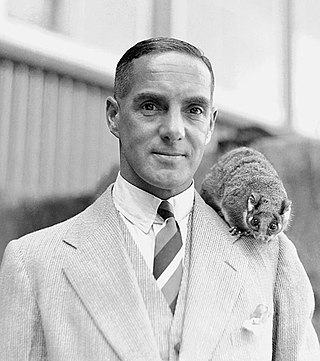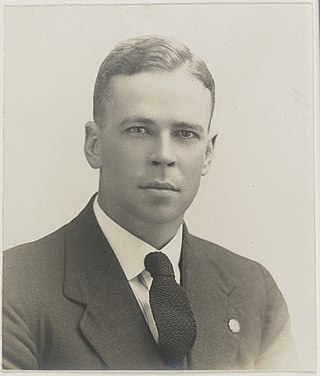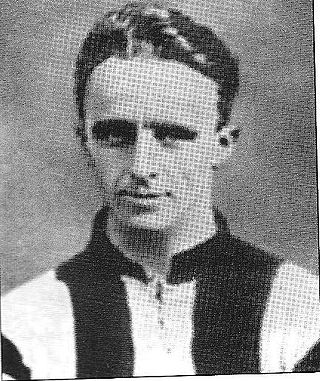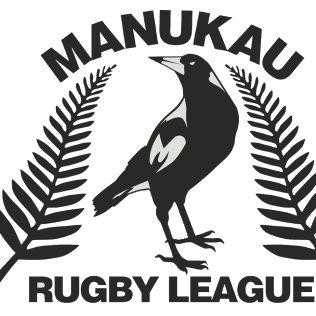Notes
- ↑ Arthur Bull at CricketArchive
- ↑ "Pairs title for Wellingboro'". Daily Herald. 12 August 1932. p. 14 – via British Newspaper Archive.
Arthur Herbert Bull was an English cricketer and lawn bowler who played for Northamptonshire from 1913 to 1924 and was club captain in the 1923 and 1924 seasons. He was born in Wellingborough on 23 January 1892 and died in Ingoldisthorpe, Norfolk on 18 December 1965. He appeared in 36 first-class matches as a righthanded batsman who scored 538 runs with a highest score of 44. [1]
He won the English National pairs title in 1932 with his brother George, bowling for the Wellinborough Bowls Club. [2]

Arthur Edward Robert Gilligan was an English first-class cricketer who captained the England cricket team nine times in 1924 and 1925, winning four Test matches, losing four and drawing one. In first-class cricket, he played as an amateur, mainly for Cambridge University and Sussex, and captained the latter team between 1922 and 1929. A fast bowler and hard-hitting lower order batsman, Gilligan completed the double in 1923 and was one of Wisden's Cricketers of the Year for 1924. When his playing career ended, he held several important positions in cricket, including that of England selector and president of the Marylebone Cricket Club (MCC). A popular figure within cricket, he was widely regarded as sporting and friendly.

Herbert Sutcliffe was an English professional cricketer who represented Yorkshire and England as an opening batsman. Apart from one match in 1945, his first-class career spanned the period between the two world wars. His first-class debut was delayed by the First World War until 1919 and his career was effectively terminated in August 1939 when he was called up for military service in the imminent Second World War. He was the first cricketer to score 16 centuries in Test match cricket. He is most famous for being the partner of Jack Hobbs and the partnership between the two, Hobbs and Sutcliffe, is widely regarded as the greatest partnership of all time.

William Harold PonsfordMBE was an Australian cricketer. Usually playing as an opening batsman, he formed a successful and long-lived partnership opening the batting for Victoria and Australia with Bill Woodfull, his friend and state and national captain. Ponsford is the only player to twice break the world record for the highest individual score in first-class cricket; Ponsford and Brian Lara are the only cricketers to twice score 400 runs in an innings. Ponsford holds the Australian record for a partnership in Test cricket, set in 1934 in combination with Don Bradman —the man who broke many of Ponsford's other individual records. In fact, he along with Bradman set the record for the highest partnership ever for any wicket in Test cricket history when playing on away soil

Leonard Stephen Davies was a Welsh professional footballer. Born in Cardiff, he trained as a marine engineer before becoming a footballer, making his senior debut for his hometown club Cardiff City in 1919 in the Southern Football League. Cardiff joined the Football League the following year but Davies remained a reserve until establishing himself in the first team in late 1922. He scored Cardiff's first hat-trick in the Football League in January 1922 and was the club's top scorer in all competitions during the campaign.
David Halliday was a Scottish football player and manager. He achieved numerous distinctions and high rankings as a prolific goal-scoring forward with six senior clubs; St Mirren, Dundee, Sunderland, Arsenal, Manchester City and Clapton Orient. He bookended his senior career playing at then non-league Queen of the South and Yeovil and Petters United. Halliday's three goals in the FA Cup proper for Yeovil give him a career total of 368 senior goals. From being player-manager at Yeovil, he went on to win trophies managing Aberdeen and Leicester City.
Arthur Clarence Hillier Chandler was a professional footballer in the 1920s and 1930s. He is most famous at Leicester City, where he is the club's all-time record goal scorer, with 273 goals, who also played for Queens Park Rangers and Notts County.
Asen Panchev was а Bulgarian footballer who played as a left wing.
Arthur Reginald Dorrell was an English international footballer who played on the left-wing. He was the son of former Villa player William Dorrell. He played for Aston Villa between 1919 and 1931, scoring 65 goals in 390 appearances and winning four England caps. He played in both the 1920 and 1924 FA Cup finals, the first of which Villa won. He then retired after a season with Port Vale.

William Hardy was an English professional footballer who played as a half back. He began his career with his hometown side Bedlington United before moving to Scotland where he made his professional debut with Heart of Midlothian in 1910 at the age of 18. He remained with the side for a year, making sporadic appearances, before joining Football League Second Division side Stockport County. However, he made only one appearance for the first team.

William George Berry, known in England as Bill Berry and in Francophone nations as George Berry or Georges Berry, was an English professional footballer who made over 130 appearances as an outside left in the Football League for Brentford. He also played league football for Gillingham, Charlton Athletic, Crystal Palace and Bournemouth & Boscombe Athletic and after his retirement he had a 30-year management career with clubs in France, Belgium, Tunisia and Luxembourg.
Charles Harry Bull was an English sportsman who played in 175 first-class cricket matches between 1929 and 1939 for Kent County Cricket Club and later for Worcestershire County Cricket Club. Bull also represented England at table tennis, winning a number of World Table Tennis Championships medals between 1928 and 1932.

William Tempest was an English footballer who played on the left-wing. He played for Stoke between 1912 and 1924 before finishing his career in 1926 with Port Vale.
Leonard Armitage was an English footballer who could play both in defence and attack. He made 284 league appearances in a 15-year career in the Football League.
Harry Sellars was an English footballer and football manager, who played in the English Football League for Stoke City. He made 395 appearances for Stoke in all competitions, and helped the club to win the Third Division North title in 1926–27 and the Second Division title in 1932–33. He went on to briefly manage League of Ireland side Dundalk in 1947. His son John also played for Stoke in the 1950s. Together, father and son played 808 league and cup games for the club.

The Manukau Magpies are a rugby league football club based in Māngere, a suburb of Auckland in New Zealand, who compete in the Auckland Rugby League. The club was established in March 1912 after a meeting in Onehunga. That year they fielded a senior team and two junior teams.
Hubert Dickson, generally known as Hugh or Hughie Dickson, was an English footballer who scored 37 goals from 402 appearances in the Football League playing for Darlington. He also played non-league football for Gainsborough Trinity, Worksop Town and Newburn. His primary position was right half, but he also played at inside forward and, towards the end of his career, at right back.
John Arthur Deed was an English amateur cricketer who played for Kent County Cricket Club between 1924 and 1930. He was born in Sevenoaks in Kent in 1901.
The 1923–24 season was the 29th season of competitive football by Southampton, and the club's second in the Second Division of the Football League. Having finished in a mid-table position the previous season, the club made progress towards their goal of promotion to the First Division by finishing fifth in the second flight in 1923–24. The campaign started off relatively poorly, as the club won just two of their opening ten fixtures and found themselves around the middle of the table again. However, the team's performances began to improve, and by the middle of January they had made it to the top five in the division. With tough competition at the higher end of the Second Division, Southampton continued to drop points in key matches and finished the season in fifth place with 17 wins, 14 draws and 11 losses.
The 1924–25 season was the 30th season of competitive football by Southampton, and the club's third in the Second Division of the Football League. Following the 1923–24 season, in which the club finished just three points shy of the First Division promotion places in fifth place, the Saints dropped two positions to finish seventh in the league. As with the last season, Southampton began their Second Division campaign poorly and found themselves at the bottom of the table after two losses in their first three games. The side continued to struggle to pick up wins, but steadily began making their way up the table over the next few months. A number of wins over the Christmas period and an eight-game unbeaten run at the end of the season helped Southampton finish in seventh place with 13 wins, 18 draws and 11 losses.
The 1932–33 season was the 38th season of competitive football by Southampton, and the club's 11th in the Second Division of the Football League. It was another disappointing campaign for the Saints, who finished mid-table and rarely competed for promotion to the First Division. After a slow start to the season, the club had established themselves in the top half of the table by October with a string of victories. By the end of the calendar year, Southampton had dropped as low as 14th in the Second Division table – the position in which they finished the previous season – after a period of poor form in December. Wins were hard to come by in the second half of the season, but a strong run of results in April meant that the side finished 12th with 18 wins, five draws and 19 losses, seven points above the first relegation place.